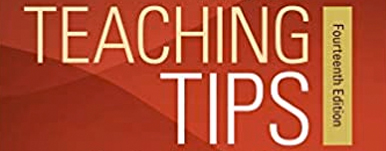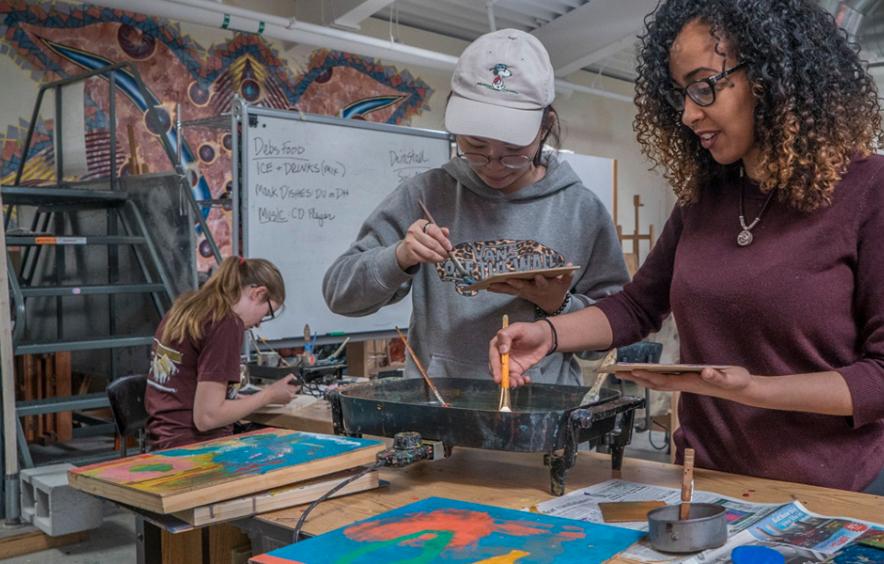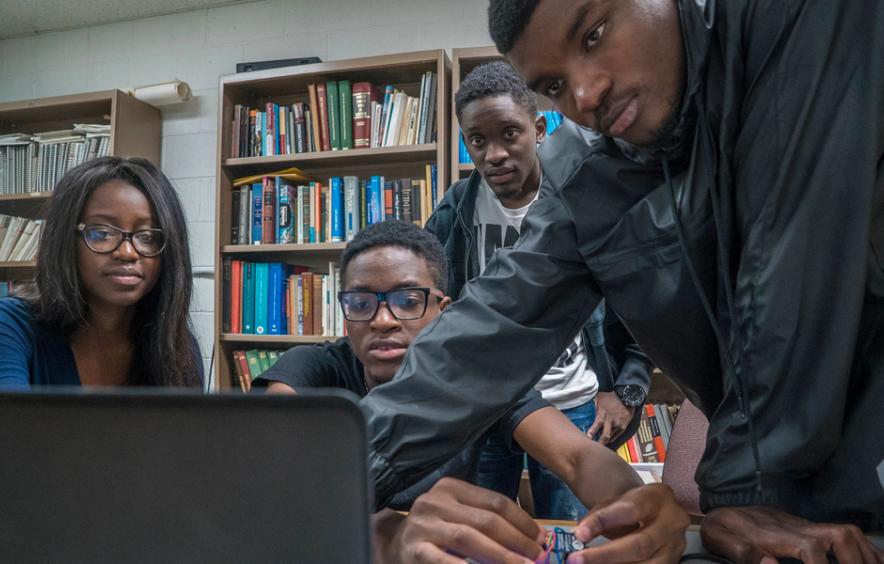Inclusive Pedagogy
This article covers:
- What is Inclusive Pedagogy
- Teaching Tools
- Supportive Resources
What is Inclusive Pedagogy?
Inclusive Pedagogy is a student-centered approach to teaching that engages the wealth of intersecting social identities and positionalities that all students bring to the classroom. It must not be an afterthought, rather, it should permeate every aspect of curriculum and course design, classroom management, and assessment of teaching and learning (Iturbe-LaGrave, 2018).
Through Inclusive Pedagogy, faculty can reimagine their teaching and dismantle oppressive practices that have hindered the academic success of historically underrepresented students in American Higher Education. It is an approach to teaching that requires us to recognize, assess, and respond to microaggressions; to co-construct knowledge, community agreements, and curricula through which every student's experiences in the world are validated and seen (Iturbe-LaGrave, 2018).
While this module is not an exhaustive nor comprehensive overview, it provides tools to begin pivoting toward this holistic and transformative way of teaching and learning.
-
Definitions
"[Inclusive] pedagogy requires that educators embrace their students as whole human beings consisting of mind, body, and soul and create interactive and dynamic classroom environments that inspire deep and meaningful transformational learning" (Tuitt et al., 2016, p. 218).
"Inclusive learning and teaching in higher education refers to the ways in which pedagogy, curricula, and assessment are designed to engage students in learning that is meaningful, relevant, and accessible to all. It embraces a view of the individual and individual difference as the source of diversity that can enrich the lives and learning of others" (Hockings, 2010, p.1)
-
Frameworks
Inclusive frameworks include but are not limited to:
- Inclusive Pedagogy (Tuitt, et. al., 2016)
- Trauma-Informed Pedagogy (Harris, et. al, 2001)
- Culturally Relevant Pedagogy (Ladson-Billings, 1995)
- Culturally Sustaining Pedagogies (Paris et. al., 2017)
- Funds of Knowledge (Moll, L., Amanti, C., Neff, D., & Gonzalez, N., 1992)
- Humanizing Pedagogy (Del Carmen Salazar, 2013)
- Intersectional Pedagogy (Case, 2016)
- Universal Design for Learning (CAST)

Benefits of Inclusive Pedagogy
Through Inclusive Pedagogy, faculty members can:
- Engage diversity to create dynamic, engaging, and relevant individual and group learning experiences.
- Establish an environment that challenges each student to achieve academically at high levels, and furthers their path to academic success (adapted from Salazar et al., 2009)
- Constructively handle difficult moments in the classroom when controversial material is discussed, and classroom discussions become heated (adapted from Salazar et al., 2009)
- Co-create and foster a collegial environment in which students feel comfortable sharing their ideas, thoughts, and questions (adapted from Salazar et al., 2009)
- Support the success of all students regardless of background and ability (Salazar et al., 2009)
"Even though some of us might wish to conceptualize our classrooms as culturally neutral or might choose to ignore the cultural dimensions, students cannot check their sociocultural identities at the door, nor can they instantly transcend their current level of development [...] Therefore, it is important that the pedagogical strategies we employ in the classroom reflect an understanding of social identity development so that we can anticipate the tensions that might occur in the classroom and be proactive about them." (Ambrose et. al., 2010, pp. 169-170).

Key Considerations
-
Climate
Climate is affected not only by blatant instances of inequality directed towards a person or group of people but also by smaller, more subtle "micro-inequities" that can accumulate to have significant negative impacts on learning (Hall, 1982).
-
Classroom climate
Classroom climate is defined as “the intellectual, social, emotional, and physical environments in which our students learn. Climate is determined by a constellation of interacting factors that include faculty-student interaction, the tone instructors set, instances of stereotyping or tokenism, the course demographics (for example, relative size of racial and other social groups enrolled in the course), student-student interaction, and the range of perspectives represented in the course content and materials” (Ambrose et. al., 2010, p. 170).
-
Stereotypes
Stereotypes cause alienation and marginalization among those who are the target of unfair generalizations. Students who have experienced stereotypes or expect to be viewed or judged in a certain way may encounter tensions and cognitive disturbances that interfere with learning (Ambrose et al., 2010, pp. 173-179).
-
Microaggressions
Microaggressions are brief and commonplace daily verbal, behavioral and environmental indignities, whether intentional or unintentional, that communicate hostile, derogatory, or negative racial, gender, sexual orientation, and religious slights and insults to the target person or group (Sue, 2010). Microaggressions affect students' ability to learn; create a hostile and invalidating campus or work climate (Rowe, 1990; Solórzano et al., 2000); and lower productivity and problem-solving abilities (Cadinu et al., 2005; Dovidio, 2001; Salvatore & Shelton, 2007).
Racial Microaggressions are subtle, innocuous, preconscious, or unconscious degradations, putdowns, verbal and kinetic -me.g., staring, averted gazes, gestures, exasperated looks, and body language. It is important to remember that the cumulative burden of a lifetime of microaggressions can theoretically contribute to augmented morbidity and flattened confidence (Pierce, 1995).
Gender Microaggressions devaluate women’s contributions, objectify them as sex objects, dismiss their accomplishments, and limit their effectiveness in social, educational, employment, and professional settings (Banjo & Greenwald, 1995; Benokraitis, 1997; Morrison & Morrison, 2002).
Sexual-Orientation Microaggressions thematically contain overt and covert messages that include seeing LGBTs in a narrow sexual way, exposing them to homophobia, heterosexist language, religious concepts of sinfulness, to beliefs of abnormality, and to invalidations of attitudes, beliefs, and behaviors, which are central to healthy sexual identities (Sue, 2010).
-
Tone
The tone of a class environment is influenced strongly by the instructor. Studies show that students approach faculty who express encouragement more so than faculty who come off as punitive. Tone can be set by instructors through their interactions with students and through other modes of communication including syllabus (Ambrose et al. 2010).
Microinsults (often unconscious) communications that convey rudeness and insensitivity and demean a person (Sue, 2010).
Microinvalidations (often unconscious) exclude, negate, or nullify the psychological thoughts, feelings or experiential reality (Sue, 2010).
-
Content
Content includes the course materials, examples and metaphors, case studies and project assignments used to illustrate the ideas being taught. Content that includes a variety of perspectives or is representative of multiple views is more conducive to a positive climate (Ambrose et al. 2010).
Recommended Articles

Teaching Inclusively in Higher Education
Recommended Chapter: "Students as Cultural Beings". Moira A. Fallon and Susan C. Brown's Teaching Inclusively in Higher Education is a collaborative volume written by scholars in the field of education interested in pedagogical methods and strategies that make learning accessible to a more diversified college population...
Read it at DUNot at DU? Find the book online

Diversity and Motivation: Culturally Responsive Teaching in College
When the first edition of Diversity and Motivation was published in 1995, it became a premier resource for faculty and administrators seeking effective and practical strategies that foster motivation among culturally diverse student groups...
Read it at DUNot at DU? Find the book online

Teaching Inclusively: Resources for Course, Department and Institutional Change in Higher Education
Recommended Chapter: "Creating Inclusive Classrooms: A View Through the Student Lens". Teaching Inclusively brings together a broad array of current "best practices"...
Read it at DUNOte at DU? Find the book online

W.J. McKeachie’s Teaching Tips
Recommended chapter: "Teaching Culturally Diverse Students". This indispensable handbook provides helpful strategies for dealing with both the everyday challenges of university teaching and those that arise in efforts to maximize learning for every student...
Read it at DUNot at DU? Find the Book Online

Racial Microaggressions and Difficult Dialogues on Race in the Classroom
A qualitative study supports the observation that difficult dialogues on race and racism are often triggered by racial microaggressions that make their appearance in classroom encounters or educational activities and materials...
Read it at DUNot at DU? Read the PDF on Sage Journals
-
References
Ambrose, S. A., Bridges, M. W., DiPietro, M., Lovett, M. C., & Norman, M. K. (2010). How learning works: Seven research-based principles for smart teaching. John Wiley & Sons. Benokraitis, N. V. (1997). Subtle sexism: Current practice and prospects for change. Sage Publications, Inc.
Brown, S. C. (2010). Students as cultural beings. In M. Fallon & S.C. Brown (Eds.), Teaching inclusively in higher education. (pp. 17-37). Information Age Publishing Co.
Cadinu, M., Maass, A., Rosabianca, A., & Kiesner, J. (2005). Why do women underperform under stereotype threat? Evidence for the role of negative thinking. Psychological Science, 16(7), 572-578.
Cohn, E. & Gareis, J. (2007). Faculty members as architects: Structuring diversity-accessible courses. In J. Branche, J.W. Mullennix, E.R. Cohn (Eds.), Diversity across the curriculum. (pp. 18-22). Anker Publishing.
Dovidio, J. F. (2001). On the nature of contemporary prejudice: The third wave. Journal of Social Issues, 57(4), 829-849.
Ginsberg, M.B. & Whodkowski, R.J. (2009). Diversity and Motivation: Culturally responsive teaching in college, (2nd ed.). San Francisco, CA: Jossey-Bass. Chapter 1.
Greenberg, J., & Perry, A. (2005) Creating inclusive classrooms: A view through the student lens. In M.L. Ouellet (Ed.) Teaching Inclusively: Resources for course, department and institutional change in higher education. (pp. 551-565). New Forums Press
Hall, S. (1982). The classroom climate: A chilly one for women? Washington D.C.: Association of American Colleges.
Milem, J., Chang, M., & Antonio, A. (2005). Making diversity work: A researched-based perspective. AAC&U.
Pierce, C.M. (1995). Stress analogs of racism and sexism: Terrorism, torture, and disaster. P.P.R. In C.V. Williw, B.M. Kramer, & B.S. Brown (Eds.) (Ed.) Mental Health, racism, and sexism (pp. 277.293).
Rowe, M.P. (1990). Barriers to equality: The power of subtle discrimination to maintain unequal opportunity. Employee Responsibilities and Rights Journal, 3(2), 153-163.
Salazar, M., Norton, A., & Tuitt, F. (2009). Weaving promising practices for inclusive excellence into the higher education classroom. In L.B. Nilson and J.E. Miller (Eds.) To improve the academy. (pp. 208-226).
Salvatore, J., & Shelton, J. N. (2007). Cognitive costs of exposure to racial prejudice. Psychological Science, 18(9), 810-815.
Solórzano, D., Ceja, M., & Yosso, T. (2000). Critical race theory, racial microaggressions, and campus racial climate: The experiences of African American college students. The Journal of Negro Education, 69(1/2), 60-73.
Sue, D.W. (2010). Microaggressions in Everyday Life: Race, Gender, and Sexual Orientation. NJ: John Wiley & Sons.
Suinn, R. (2010). Teaching culturally diverse students. In W.J. McKeachie's teaching tips. (pp. 151-170). Houghton Mifflin Company.
Wing Sue, D., Lin, A.I., Torino, G.C., Capodilupo, C.M., & Rivera, D.P. (2009). Racial microaggressions and difficult dialogues on race in the classroom. Cultural Diversity and Ethnic Minority Psychology, 15 (20), 183-190.

Teaching Tools
Questions to Ask Yourself

How, if at all, have you integrated diversity into your course?

Have you considered content, readings, lectures, discussion topics, perspectives, examples, case studies, problems, and stories? Is the content balanced in its portrayal of diverse groups?

Are there multiple ways to access course materials and engage in learning that accounts for the range of ways of learning that may be present in your class?

Have you assembled a range of instructional activities and assignments that offer multiple opportunities for assessing student progress?

Is your course designed in a manner that facilitates the development of an inclusive learning community? Will you establish ground‐rules and solicit feedback related to how students are experiencing the learning environment?

Does your syllabus signal to students that diverse perspectives are welcomed; that accommodations can be made; and that acts of intolerance and disrespect will not be permitted? Do you have a diversity and disability statement on your course syllabus?

Have you anticipated and prepared for how students may respond to potentially charged topics or situations that may emerge in your class?

Have you created opportunities to get know your students on a personal and individual basis?

Finally, have you created a vision for promoting inclusive excellence in your classroom? Do you have a sense of what teaching inclusively would feel like and look like?
Adapted from Salazar et al., 2009.
Syllabus Statements
Inclusive syllabus statements show students that you respect and value the multiplicity of identities, beliefs, cultural backgrounds, and skills in your classroom. Syllabus statements should be actively shared with students, and not just be printed on paper. Think of activities and ways to engage students in deepening their understanding of these statements, and share why it is important for you to incorporate them into your course. These statements also signal that you are aware of contemporary issues and conversations around diversity. Below are suggested statements from the Office of Teaching and Learning.
-
Honor Code
At the University of Denver, we create an academic learning environment grounded in Academic Integrity. Students are expected to engage honestly and demonstrate responsibility in research and academic assignments. Therefore, all work and grades should result from the Student's own understanding of the materials and their effort.
Specifically, all work submitted in this course must be your own and produced exclusively for this course. The use of sources (ideas, quotations, paraphrases) must be properly acknowledged and documented. For the consequences of violating the Academic Misconduct policy, refer to the University of Denver website on the Honor Code (www.du.edu/honorcode). See https://www.du.edu/studentlife/studentconduct for general information about expectations from the Office of Student Rights and Responsibilities.
University of Denver Student Rights and Responsibilities. (2020). Honor Code. Retrieved from https://www.du.edu/studentlife/studentconduct/
-
Religious Accommodation Statement
The University of Denver has an enduring commitment to diversity and inclusive excellence, including religious diversity. The University honors and respects students’ rights to observe sincerely held religious beliefs or practices and provides an educational environment in which all students are free from harassment and discrimination based on religion consistent with the requirements of federal, state and local law. As part of this commitment, the University provides reasonable accommodations for students sincerely held religious beliefs or practices unless the University determines that such an accommodation would fundamentally alter the curriculum or academic program. Students should follow the procedures in requesting a religious accommodation for academic requirements here: https://www.du.edu/studentlife/religiouslife/process
University of Denver Religious and Spiritual Life. (2020). Religious Accommodation Statement. Retrieved from https://www.du.edu/studentlife/religiouslife/process ) -
Land Acknowledgement
We recognize that the University of Denver resides on the traditional territories of the Arapaho, the Cheyenne, and the Ute. The Treaty of Fort Laramie (1851 and 1861) and Cessation 426 within the treaties of Confederated Tribes of Arapaho and Cheyenne are examples of how US federal policy disrupted these Indigenous nations from their homeland. DU has a troubling history with Indigenous communities and the University acknowledges that John Evans, DU founder, was culpable in the events leading up to the Sand Creek Massacre. With that knowledge in mind, it is with much gratitude that we recognize the descendant communities of the Northern Cheyenne Tribe of Montana, the Northern Arapaho Tribe of Wyoming, and the Southern Cheyenne and Arapaho Tribes of Oklahoma. Throughout time, over 100 different tribal nations have a history of occupying the lands now defined as the State of Colorado. It is important to emphasize that the lands we occupy continues to be held in stewardship by these Indigenous communities. Finally, it is important to critically reflect upon and personally reconcile how the aforementioned genocidal acts against Indigenous communities intersect with our learning and collaboration around the study of higher education. To learn more about DU’s recognition and reconciliation of their involvement in the Sand Creek Massacre, please review the John Evan’s report at https://portfolio.du.edu/evcomm/page/52699
Nelson, C. (2020). Syllabus: Articulating and Enacting Decolonization in Higher Education. Retrieved from https://www.academia.edu/37371145/Syllabus_Articulating_and_Enacting_Decolonization_in_Higher_Education?auto=download -
Student Athletes
Student-athletes are responsible for informing their instructors of any class days to be missed due to athletics events in which they are participating. Student-athletes will be provided with a schedule of travel dates that coincide with class dates and absence policy to present to instructors. This must be signed by the instructor and returned to the assigned athletics adviser. It is the responsibility of the student-athlete to make arrangements with instructors regarding any missed lectures, assignments, and/or exams by the end of the first week of class.
University of Denver. (2020). Student Athletes Statement. Retrieved from https://otl.du.edu/plan-a-course/teaching-resources/sample-syllabus-statements/
-
Basic Needs Security
To assist our students in maintaining their safety, health, and well-being, it is important to identify difficulties as soon as possible. When a student is in distress there are often indicators long before a situation escalates to a crisis. As faculty and staff members, you may be the first to notice signs of distress. The University has many resources available for you to consult with including the Health and Counseling Center (HCC) and Student Outreach & Support (SOS). It is important that once you notice these signs of distress that you communicate these through the SOS Referral system. In addition to making a referral to SOS Referral, we also encourage you to have a direct conversation with the student to gather information, express your concern, and share the resources available to the student to support them in navigating this challenging time.
Whether you are able to have a conversation with the student or not, it is critical to always submit a referral of your concern through the SOS Referral system. Please understand that referring not only helps support students but is also documentation that the University activated appropriate protocol to address concerning behavior that may have safety implications for individuals and the campus community. This type of documentation is very important given liability issues. Please see the red folder in assisting you to recognize and support students in distress
Here is a statement that a professor can include in any syllabus to let students know that they do not have to face these problems alone.
Any student who faces challenges including but not limited to food insecurities, housing, wellbeing and believes this may affect their performance in the course is urged to contact the Office of Student Outreach and Support (SOS) for resources and support at 303.871.2400 or at https://www.du.edu/studentlife/studentsupport Furthermore, please notify me if you are comfortable in doing so. This will enable me to provide any resources that I may possess.
University of Denver Outreach and Support. (2020). Basic Needs Statement. Retrieved from
https://www.du.edu/studentlife/studentsupport/support_outreach/index.html -
Inclusive Learning Environments
(Developed by the Faculty Senate)
In this class, we will work together to develop a learning community that is inclusive and respectful. Our diversity may be reflected by differences in race, culture, age, religion, sexual orientation, socioeconomic background, and myriad other social identities and life experiences. The goal of inclusiveness, in a diverse community, encourages and appreciates expressions of different ideas, opinions, and beliefs, so that conversations and interactions that could potentially be divisive turn instead into opportunities for intellectual and personal enrichment. A dedication to inclusiveness requires respecting what others say, their right to say it, and the thoughtful consideration of others’ communication. Both speaking up and listening are valuable tools for furthering thoughtful, enlightening dialogue. Respecting one another’s individual differences is critical in transforming a collection of diverse individuals into an inclusive, collaborative and excellent learning community. Our core commitment shapes our core expectation for behavior inside and outside of the classroom.
-
Collective Responsibility for Addressing Privilege and Oppression
We acknowledge that racism, classism, ableism, homophobia, transphobia, sexism, and other forms of oppression exist. Any critical examination of oppression requires us to recognize that we have been systematically taught misinformation about our own group as well as about members of other groups. It also means that, if we are a part of a dominant group (e.g., white, male, upper/middle class, able-bodied, and/or heterosexual), we have unearned privilege that carries into the classroom and for which we are responsible. Being responsible means examining our words and actions and considering how we can be allies to others. We cannot be blamed for the misinformation that we have learned and for taking unconscious advantage of our privilege, but we will be held responsible for repeating misinformation or engaging in oppressive behavior once we have learned otherwise.
Trost, J. (2019). University of St. Thomas Dougherty Family College Collective Responsibility for Addressing Privilege and Oppression. Retrieved from https://www.stthomas.edu/media/centerforfacultydevelopment/pdf/2018UST_InclusiveExcellenceSyllabusStatementExamples.pdf
-
Student Conduct and Online Courses
As we move to an online teaching environment for the spring quarter, the following defines the restrictions and expectation of student behavior, as governed by the Honor Code. In particular, this policy articulates application of the Unauthorized Use section of the Honor Code under Academic Integrity (A.2.) and Theft (M) in the Student Rights & Responsibility section of the Honor Code.
RESTRICTION OF AUDIO OR VISUAL RECORDING, REPRODUCTION, AND DISTRIBUTION OF CONTENT IN ONLINE COURSES
At the University of Denver, we seek to protect the in online learning environments. To this end, students may not record, reproduce, screenshot, photograph, distribute or share in any way (including electronically or posting in any web environment) any video, audio, or visual content from their online courses, except if necessary, to communicate with University administrators or the Disability Service Program. Students also many not share links to the course in canvas, or to the zoom meetings. This restriction includes but is not limited to:
- Pre-recorded and live lectures
- Live discussions
- Discussion boards
- Chats
- Simulations
- Posted course materials
- Faculty feedback forms
- Audiovisual materials that accompany lectures/discussions, such as slides
- Virtual whiteboard notes/equations, etc.
- Assignments
- Tests, quizzes and surveys
Instructors may record the course and provide the recording to students registered in the course for that section and quarter to facilitate full course participation.
II. EXCEPTION FOR ACCOMMODATIONS
Students with disabilities who need to record classroom lectures or discussions must contact the Disability Services Program (DSP) to register, request, and be approved for an accommodation. If allowed through a documented DSP accommodation, all students are advised that students with documented DPS accommodations may record classroom activities for this purpose. Such recordings are to be used solely for individual or group study with other students enrolled in the class that quarter/semester. They may not be reproduced, shared in any way (including electronically or posting in any web environment) with those not in the class in that quarter.
III. GUIDANCE ON RESPECTFUL & APPROPRIATE BEHAVIOR DURING ONLINE COURSES
In addition to the usual guidance on respectful communication with instructors and peers, the transition to an online environment raises new constraints and opportunities.
Communication Preferences and Constraints
Students and instructors are expected to outline their communication preferences and constraints; for example, instructors may specify the turnaround time for email or canvas replies and are not expected to be constantly available. Similarly, assignments should clearly specify due dates and times and late policies. Relatedly, students and instructors should indicate their availability to communicate live (during class times or office hours through zoom or canvas) versus the need to communicate asynchronously (for example due to time zone differences, workspace restrictions, caregiving demands, and/or internet access). Clear and advanced communication should prevent mismatched expectations and support the best learning environment.
-
Zoom Etiquette
Students and instructors may choose to use or refrain from using video on zoom sessions. It is not always possible to include video, though it is appropriate to encourage its use when possible. To protect one’s privacy, many people choose to use an alternate background for zoom versus their real-time background. This is acceptable; however, please keep in mind not all platforms have this feature. Please also select an innocuous and non-offensive background if you choose this option. Illicit, exploitive, or otherwise inappropriate content is prohibited.
All students are expected to abide by the Student Conduct Policies associated with the Honor Code regardless of whether students are on-campus or learning remotely through an online learning platform. These relevant Student Conduct Policies are including but not limited to Impediment and Violation of Professional Standards as defined under Academic Integrity (A.6. and A.8, respectively), Harassment (F) Interference (H), Non-compliance (I), Provocation (L) from the Students Rights and Responsibilities Section. Students who violate this policy will be reported to The Office of Student Rights & Responsibilities and may be subject to both legal sanctions for violations of copyright law and disciplinary action under Student Rights & Responsibilities Policies.
-
Inclusive Assessment Statement
In this class, we will work collaboratively to create space for everybody to learn, regardless of student, teaching apprentice, or professor roles. With its commitment to quality education, the University uses assessment as a tool for professors to design and deliver inclusive learning environments. Some assessments help professors learn how to make teaching pivots in the moment so they can immediately respond to your needs. Other assessments help students learn how to engage more deeply with the course content. Some assessments feel less like completing an assignment or less like taking a test, but seem more like engaging in an activity. Some assessments are graded, other assessments are not graded, but all assessments––whether they come in the form of minute papers or exams or responses to a discussion prompt––are designed for robust learning.
-
Title IX
Gender violence can happen to anyone regardless of race, class, age, appearance, gender identity, or sexual orientation. The University of Denver is committed to providing an environment free of discrimination on the basis of sex (gender), including sexual misconduct, sexual assault, relationship violence, and stalking. The Center for Advocacy, Prevention and Empowerment (CAPE) provides programs and resources to help promote healthy relationships, teach non-violence and equality, and foster a respectful and safe environment for all members of the University of Denver community. All services are confidential and free of charge.
For assistance during business hours, call 303-871-3853 and ask to speak to the Director of CAPE. After hours, please call the Emergency & Crisis Dispatch Line at 303-871-3000and ask to speak to the CAPE advocate on call.
University of Denver Center for Advocacy, Prevention and Empowerment (CAPE). (2020). Title IX. Retrieved from https://otl.du.edu/plan-a-course/teaching-resources/sample-syllabus-statements/
-
Mental Health and Wellness
As part of the University’s Culture of Care & Support we provide campus resources to create access for you to maintain your safety, health, and well-being. We understand that as a student you may experience a range of issues that can cause barriers to learning, such as strained relationships, increased anxiety, alcohol/drug concerns, depression, difficulty concentrating and/or lack of motivation. These stressful moments can impact academic performance or reduce your ability to engage. The University offers services to assist you with addressing these or ANY other concerns you may be experiencing. If you or someone you know are suffering from any challenges, you should reach out for support. You can seek confidential mental health services available on campus in the Health & Counseling Center (HCC) and My Student Support System (My SSP). Another helpful campus office is Student Outreach & Support (SOS), where staff work with you to connect to all the appropriate campus resources (there are many!), develop a plan of action, and guide you in navigating challenging situations. If you are concerned about yourself and/or one of your peers, you can send a SOS referral.
More information about HCC, MY SSP, and SOS can be found at:
- Health & Counseling Services
- My SSP 24/7 confidential services for students
- Student Outreach & Support (SOS) and SOS Referrals
University of Denver. (2020). Mental Health and Wellness Statement. Retrieved from https://otl.du.edu/plan-a-course/teaching-resources/sample-syllabus-statements/
-
Students with Disabilities/Medical Issues
(developed by the Disability Services Program – more information and updates available at the DSP Faculty & Staff website)
Any participant who feels s/he may need an accommodation based on the impact of a disability should contact us privately to discuss his or her specific needs. Additionally, please contact the Disability Services Program (DSP) located in room 440 of Ruffatto Hall; 1999 E. Evans Ave. to coordinate reasonable accommodations for students with documented disabilities. Phone: 303.871.3241. Information is also available online from the Disability Services website.

Ground Rules
Establishing ground rules sets the tone of a class, provides clear guidelines on how to behave and interact with one another, decreases instances of incivility, and enables students to feel safe expressing their ideas or views. Below are some techniques to establish and implement ground rules in your course as well as sample classroom norms you can adapt.
-
Think-Pair-Share Ground Rule Activity
Ask students to think-pair-share answers to the following questions. Facilitate a large group discussion to identify themes and write down ground rules on a Word document that you can share and revisit with students:
- What would you like to get out of participating in this class?
- What do you need from this group to feel safe/brave/comfortable to express your authentic thoughts, feelings, ideas, and opinions?
- What are the most important issues we need to discuss in this group?
- What guidelines can we establish to facilitate a learning environment in which we feel safe/brave/comfortable to talk about our authentic thoughts, feelings, ideas, and opinions?
- How will we recognize the intent and own the impact of our comments?
-
Discussion Ground Rule Activity
From Brookfield & Preskill, 2005
- Ask students to think about the best group discussions they have been a part of, and reflect on what made these discussions so satisfying.
- Next, ask students to think about the worst group discussions in which they have participated and reflect on what made these discussions so unsatisfactory.
- For each of the positive characteristics identified, ask students to suggest three things the group could do to ensure that these traits are present.
- For each of the negative characteristics identified, ask students to suggest three things the group could do to ensure that these traits are not present.
- Use students’ suggestions to draft a set of ground rules to which you all agree, and distribute them in writing.
- Periodically, ask the class to reflect on whether the ground rules established at the beginning of the semester are working, and make adjustments as necessary.
-
Sample Listening Ground Rules
From Caldwell & Frame, 2017
- Be fully present. Pay 100 percent attention to the words, the person’s body language, and the energy behind the words.
- Maintain absolute silence when someone is speaking. Side conversations or exchanging looks undermines safety.
- Accept other’s sharing without judgment. Don’t try to debate, correct, or give advice. Just listen, even if you don’t agree.
- Accept yourself and what you feel without judgment. Allow time to process feelings.
- Listening is enough. You don’t have to fix anyone. No need to offer solutions.
- Listen, listen, and process what you hear before speaking.
- If you don’t understand, ask for clarification. “Did I hear that right?”
- Treat the candidness of others as a gift and honor their confidentiality.
- Accept discomfort as a catalyst for change.
- Be comfortable with silence.
-
Sample Speaking Ground Rules
From Caldwell & Frame, 2017
- Speak from the “I” perspective. Talk about yourself, not others.
- Talk about experiences you have had rather than opinions or philosophies.
- When conflict arises, express feelings rather than thoughts or opinions. This helps move through conflict to new understanding.
- Give feedback offering support and respect.
- If you make mistakes, learn from them, and then let them go.
- Be honest. Say what you think and how you feel.
- Lean into the risk. Get real. Be the one to break it open.
-
Sample Discussion Ground Rules
From Stone Norton (2008) cited in Salazar, et al., 2009
- Everyone has the right to be heard.
- Be respectful while still being critical.
- No name calling.
- One person speaks at a time.
- Maintain confidentiality.
- Hold yourself and each other to high standards of excellence at all times.
- Have the humility to recognize that you do not know everything and that everyone can stand to improve.
- Recognize that everyone will start from different bases of knowledge.
Norms of Collaborative Work
Below are the Seven Norms of Collaborative Work which serve as a starting point for developing guidelines for collaborative group work in and out of the classroom. Note that these have been adapted from William Baker, Group Dynamics Associates, by faculty members in the Educational Leadership and Policy Studies Program in the Morgridge College of Education at DU.

Paraphrasing
Using a paraphrase starter that is comfortable for you: “So…” or “As you are...” or “You’re thinking…” and following the statement with a paraphrase assists members of the group to hear and understand each other as they formulate decisions.

Pausing
Pausing before responding or asking a question allows time for thinking and enhances dialogue, discussion, and decision-making.

Probing
Using gentle open-ended probes or inquiries such as, “Please say more…” or “Can you tell me more about…” or “Then, are you saying…?” increases clarity and precision of the group’s thinking.

Putting ideas on the table:
Ideas are the heart of meaningful dialogue. Label the intention of your comments. For example, you might say, “Here is one idea…” or “One thought I have is…” or “Here is a possible approach”… or “I’m just thinking out loud…”

Paying attention to self and others
Meaningful dialogue is facilitated when each group member is conscious of self and others and is aware of not only what he/she is saying, but also how it is said and how others are responding. This includes paying attention to learning style when planning for, facilitating and participating in group meetings. Responding to others in their language forms is one manifestation of this norm.

Presuming positive intentions
Assuming that other’s intentions are positive promotes and facilitates meaningful dialogue and eliminates unintentional put-downs. Using positive intentions in your speech is one manifestation of this norm.

Pursuing a balance between advocacy and inquiry
Pursuing and maintaining a balance between advocating for a position and inquiring about one’s own and others’ positions assists the group to become a learning organization.

Assessment of Classroom Climate
Ungraded or formative assessment is a process designed to give ongoing feedback over the course of an intervention (Allen, 2004). This type of assessment enables faculty members to reflect upon their teaching practices as the class is in progress. Subsequently, professors can shift how they teach and organize learning for students in situ rather than waiting to create changes the next time a specific course is offered. Below are some ideas on how to assess the learning environment.
In-classroom Assessment
Prompt students to anonymously answer the questions below. Collect student responses, look for themes, and address your findings in the next class session. Explain to students what changes you will make if any.
- I feel comfortable participating in this course: a) always b) sometimes c) rarely d) never
- One or two things that would make me feel more comfortable in this course would be:
- What question(s) remain in your mind?
- What are some things you don't understand well enough to ask about?
Electronic Assessment
Prepare an anonymous survey using DU's free survey software, QualtricsLinks to an external site., to inquire about students' perception of your teaching. Create questions based on specific teaching practices you employ and that you can change and modify. Communicate to students what the survey is for and how you will use the results to better accommodate their learning needs.
-
References
Allen, M.J. (2004). Assessing Academic Programs in Higher Education. Anker Publishing Company, Inc.
Brookfield, S.D. & Preskill, S. (2005). Discussion as a Way of Teaching: Tools and Techniques for Democratic Classrooms (2nd ed.) Jossey Bass.
Caldwell, M., Frame, O. (2017). Let's Get Real: Exploring Race, Class, and Gender Identities in the Classroom. Routledge.
Goldrick-Rab, Sara. (2016). Paying the Price: College Costs, Financial Aid, and the Betrayal of the American Dream. The University of Chicago Press.
Tuitt, F. (2014) Race and Higher Education: Rethinking Pedagogy in Diverse College Classrooms. Cornell University Faculty Diversity Institute Keynote Presentation.
Case, K. (2016) Toward an Intersectional Pedagogy Model: Engaged Learning for Social Justice. In Intersectional Pedagogy (pp. 1-24). Routledge.
Del Carmen Salazar, M. (2013). A humanizing pedagogy: Reinventing the principles and practices of education as journey toward liberation. Review of Research in Education, 37(1), 121-148.
Harris, M., & Fallot, R. D. (Eds.). (2001). Using trauma theory to design service systems: New directions for mental health services. San Francisco, CA: Jossey-Bass.
Hockings, C. (2010). Inclusive learning and teaching in higher education: A synthesis of research. York: Higher Education Academy.
Iturbe-LaGrave, V. (2018). “Formative Assessment and Critical Self- Reflection in the Inclusive Teaching Practices Faculty Video Consultation Protocol.” Dreams, Possibilities, and Necessity of Equity: Exploring the Transformative Potential of Assessment. American Educational Research Association (AERA), New York, NY, April 16.
Kohli, R. & Solórzano, D.G. (2012). Teachers, please learn our names!: Racial microaggressions and the K-12 classroom. Race Ethnicity and Education, 15(4), 441-462.
Ladson-Billings, G. (1992). Culturally relevant teaching: The key to making multicultural education work. In C. A. Grant (Ed.), Research and multicultural education (pp. 106- 121). London, UK: Falmer Press.
Ladson-Billings, G (1994) The Dream keepers: Successful teaching for African-American students. San Francisco: Jossey-Bass.
Ladson-Billings, G. (1995). But that’s just good teaching! The case for culturally relevant pedagogy. Theory into Practice, 34(3) 159-165.
Moll, L., Amanti, C., Neff, D., & Gonzalez, N. (1992). Funds of knowledge for teaching: Using a qualitative approach to connect homes and classrooms. Theory into Practice, 31(2), 132-141.
Paris, D., Alim, S. (2017). Culturally Sustaining Pedagogies: Teaching and Learning for Justice in a Changing World. New York, NY: Teacher’s College Press.
Tuitt, F., Haynes, C., & Stewart, S. (Eds.) (2016). Race, Equity, and the Learning Environment: The Global Relevance of Critical and Inclusive Pedagogies in Higher Education. Stylus Publishing, LLC.

Supportive Resources
-
Suggested Citation
Iturbe-LaGrave, V. (2020). DU Inclusive Teaching Practices Website: Inclusive Pedagogy Module. Retrieved from http://inclusive-teaching.du.edu/inclusive-pedagogy.
